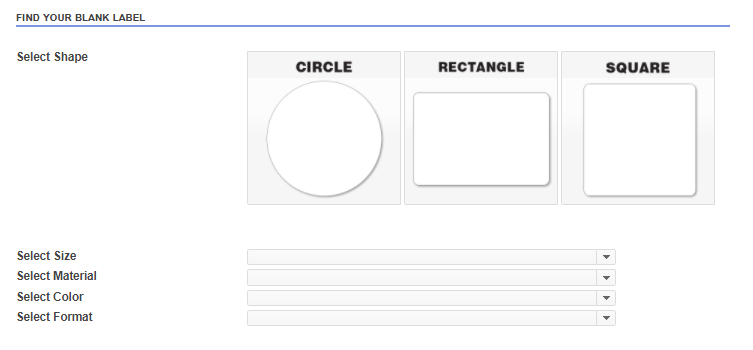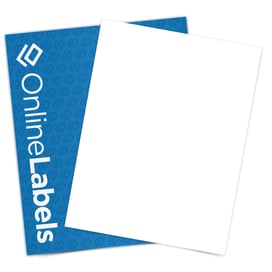Comprehending Exactly How Blank Labels Work to Enhance Your Labeling Experience
Recognizing the auto mechanics of blank labels is important for enhancing your labeling methods across numerous contexts. To totally grasp exactly how these labels can change your procedures, one should think about the various kinds offered and the myriad methods they can be tailored to fit certain requirements.

Benefits of Utilizing Blank Labels
Blank labels use a functional remedy for different identifying requirements, making them important in both individual and expert settings. Their versatility allows individuals to create tailored labels tailored to certain requirements, improving organizational performance. Whether used in home offices, retail settings, or commercial applications, blank labels help with the identification and categorization of products, records, and individual things.
One substantial advantage of blank labels is their cost-effectiveness. By allowing individuals to print only the labels they need, waste is lessened, and supply monitoring comes to be more manageable. Additionally, blank labels are suitable with numerous printing methods, consisting of inkjet and laser printers, making them accessible for various customers.

Additionally, the use of blank labels simplifies the process of upgrading details, as individuals can quickly print new labels to replace obsolete ones, guaranteeing that all items and documents are accurately identified. Overall, blank labels supply a sensible and efficient labeling option for varied applications.
Kinds Of Blank Labels Available
What choices are readily available when it comes to blank labels? Blank labels be available in a range of kinds, each suited for various applications and preferences. The most typical kinds consist of paper labels, which are versatile and cost-effective, making them ideal for daily usage. They are offered in different finishes, such as matte and shiny, permitting visual adaptability.
Another popular alternative is artificial labels, frequently made from materials like polyester or vinyl. These labels are understood for their durability and resistance to water, chemicals, and tearing, making them appropriate for severe settings. They are typically made use of in industrial setups or for labeling items that might be revealed to moisture.
Additionally, there are thermal transfer labels, which require a printer that makes use of heat to transfer ink onto the label surface. These labels are preferred for their top quality print and longevity.
Last but not least, specialty labels provide to particular needs, such as removable labels for short-term usage or high-temperature labels for severe problems. Recognizing these options permits customers to choose the most proper blank label for their special labeling needs.
Personalization Options for Labels
A wide range of modification options is offered for labels, permitting customers to customize them to specific demands and branding requirements. Customers can pick from different dimensions, shapes, and materials to make certain that the labels efficiently fit their intended objective. Common products include paper, polyester, and plastic, each using various levels of resilience and aesthetic allure.
Shade choices play an important function in customization, making it possible for brands to maintain uniformity with their company identity. Individuals can select from a range of colors or even decide for customized printing to match particular branding aspects. Additionally, labels can be published with special styles, logos, and message, improving brand recognition and aesthetic influence.
One more essential aspect is the option of adhesive. Tags can be designed with long-term, detachable, or repositionable adhesives, relying on the application needs. This flexibility permits efficient labeling remedies across numerous atmospheres, from retail to commercial settings.

Tips for Effective Labeling
Reliable labeling goes past modification; it also includes calculated considerations that enhance functionality and interaction. To achieve effective labeling, start by clearly specifying the objective of each label.
Next, focus on exposure by choosing suitable shades and fonts. High comparison in between message and history boosts readability, while larger fonts assist in fast identification. Furthermore, guarantee that labels are positioned in a consistent and logical way, making it easier for individuals to find and interpret details.
Consider the sturdiness of labels. Pick materials matched for her comment is here the specific environment where the labels will be made use of, whether it be inside your home or outdoors. Water resistant or tear-resistant alternatives might be needed depending upon the context.
Lastly, regularly review and update your labels to show any type of adjustments in details or usage. This positive strategy not just maintains clearness yet also stays clear of confusion over time. By complying with these pointers, you can make best use of the efficiency of your labeling efforts, ensuring they offer their desired objective effectively.
Applications of Blank Labels
Blank labels offer various applications throughout different industries, making them a vital tool for company and interaction. These functional labels are commonly utilized in warehouses for inventory monitoring, permitting companies to easily determine and track products. By using blank labels to storage space bins, shelves, or pallets, companies can streamline their procedures and lower the possibility of mistakes.
In the health care sector, blank labels play a crucial duty in classifying drugs and medical products, making certain appropriate identification and use. Customizable labels can include crucial information such as dosage, expiration dates, and individual information, improving safety and compliance.
In retail, blank labels aid in rates products, giving promotions, or classifying rack areas, which ultimately boosts the client experience. They enable fast updates to pricing or product info without the need for pre-printed labels.
In addition, blank labels are useful for individual usage, such as arranging home offices, crafting, or classifying food containers. Their flexibility enables individuals other to create customized services that meet details demands. On the whole, the applications of blank labels are extensive, underscoring their relevance in promoting performance and quality in different settings.
Verdict
To conclude, blank labels provide a versatile and reliable remedy for different classifying needs. Their adaptability in dimension, shape, and material enables customized applications across various settings. By leveraging personalization alternatives you can try these out and reliable labeling methods, organizations can improve quality and communication (Blank Labels). Ultimately, the assimilation of blank labels into functional procedures adds to improved performance, making them a very useful source for both personal and expert usage.